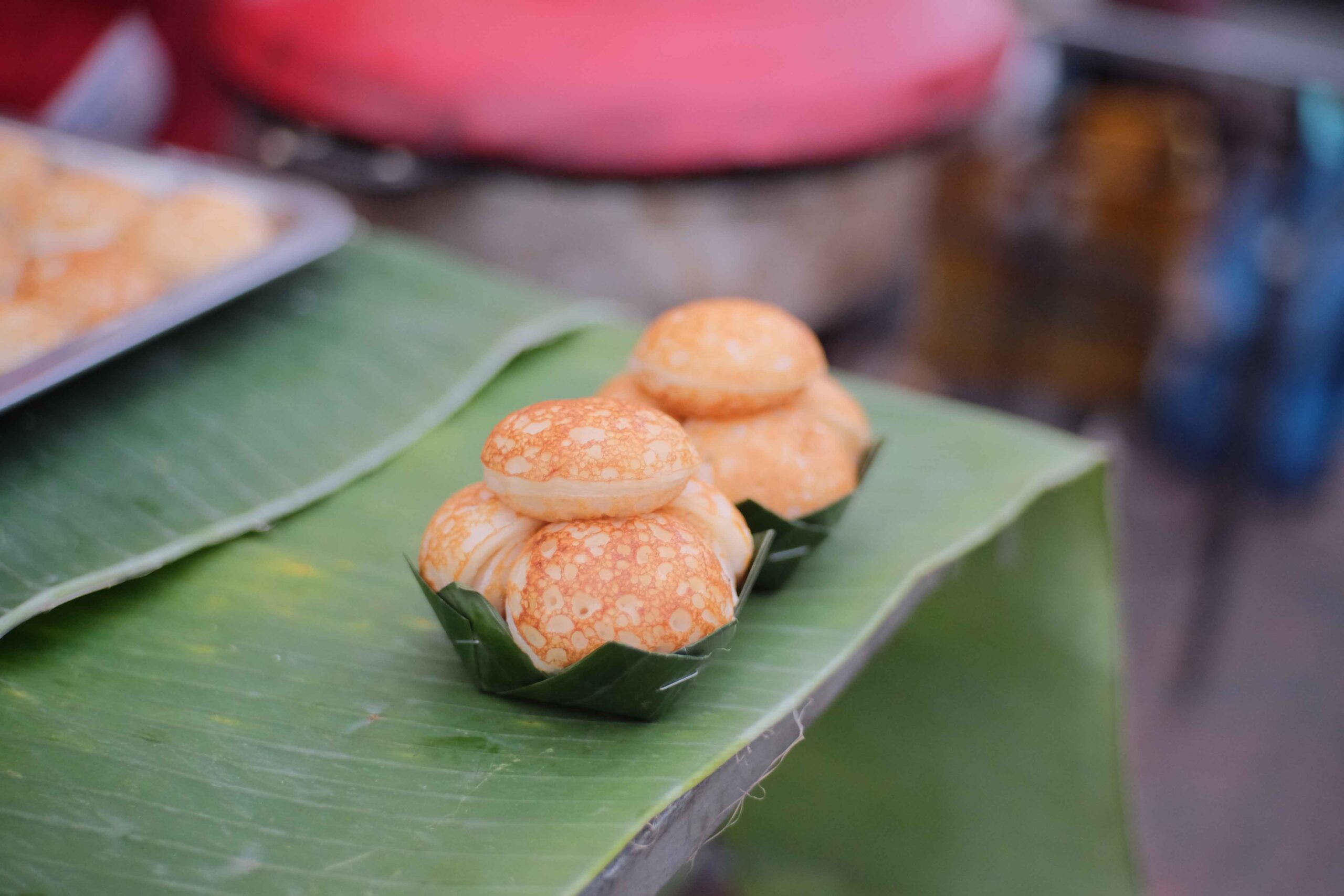Taste the city’s rich culinary heritage
Now it’s time for papaya salad! my guide Mr. Oun says. Lao papaya salad is one helluva fiery dish and it’s the last meal of my market foodie tour. I’ve been dipping into foodie spots around the temple town. I taste soups, coffee, crepes, and a winning coconut snack – and all before lunch!
“In Laos, we usually put a lot of chili in papaya salad,” Mr. Oun explains. “Here we say if it’s not spicy, it’s not delicious.” Mr. Oun normally eats the popular salad with about 10 chilies. “But for today I think two or three chilies will be enough!”
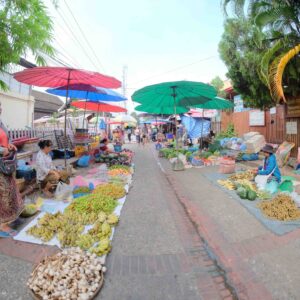
I ask Mr. Oun if his mouth explodes with a 10-chili kick. “It goes a bit red,” he lets on. I confess I normally steer clear of this firebomb. The last time I ate papaya salad in Laos it stripped the roof of my mouth.
I’m game, though. We pull up at a roadside stall busy with customers. A young woman is pounding a large, deep mortar with a pestle grinding the yellow-green papaya shreds with chilies, lime, and sugar. She tests a spoonful frequently for taste. She outsources, too: a male worker is asked to put his taste buds into action; a little boy is commandeered to chop limes.
Mr. Oun tells the stallholder the falang (me, the foreigner) could probably manage maybe two chilies. She turns around and looks me up and down. “Just one!” she announces.
I’m secretly relieved. But even with just the one red chili, I can feel my mouth begin to flame.
Our pedal started earlier in the day at the Morning Market, a straight-as-an-arrow alley that runs beside the wall of Wat Mai temple. The market branches out to food stalls, guest houses, and stalls selling clothes close to the Mekong River, but the fresh food goes on sale every morning at 05:30. It’s packed when we arrive. Women – all women – perch on a low brick wall with trays
and bags stuffed full of produce and buckets and bowls of water thrashing with live creatures. Monks in saffron robes clutching mobile phones walk through, customers mill about, and sellers balance baskets of fresh vegetables on shoulder poles as they navigate the tight alley.
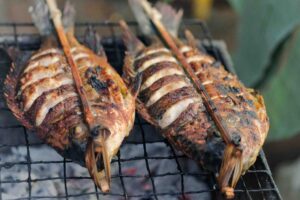
As a visitor from the West, I’m used to picking out apples, pears, plums, and onions at fresh produce markets. In Luang Prabang’s morning market, I had no idea what many of the goods for sale could be. Mr. Oun was the perfect guide for my many questions.
We pass sellers of khao lam (bamboo stuffed with a blend of black sticky rice, coconut milk, and sugar that are laid over coals for a grilling). I learned that not only is it delicious but that out of a whole crop of bamboo varieties, there’s only one bamboo trunk that can be used to make khao lam.
A slim, green, spiky wood catches my eye. It’s young rattan. “They burn the thorns off, strip the bark and then with a mortar and pestle pound it with chili and salt,” Mr. Oun says. Young rattan is eaten with sticky rice and goes into making a young rattan sauce.
Between the women selling limes, mushrooms, ginger, and red chilies, a man stands with a megaphone persuading the locals of the benefits of dark bottles of liquid he’s holding. It’s tamarind water, Mr. Oun says. The peddler tells us it’s good medicine for blood pressure.
Past piles of lush carrots, tomatoes, aromatic herbs refreshed by sprinkles of water, and spring onions are fish laid out in full, in fillets, or wriggling about in shallow bowls. Mr. Oun points out pa nai, a Mekong River common carp used to make the classic Lao dish of laap (minced fish with diced herbs), and a bucket of fermented fish sauce – pa daek, which accompanies most Lao meals.
I goggle at so many foods I’d never see in the West – palm fruit seeds that look like large white jellybeans, bamboo rats, dried buffalo lung, eels, khai phaen – a delicious snack of wafer-thin dried river weed speckled with sesame seed and garlic, and chunky chili wood – sakhan, that goes into the thick meaty Lao broth, or lam.
At the end of the long alley, we emerged into the dry goods and packaged foods area where rice is sold in enormous sacks. Luang Prabang honey is sold, as well as packaged bamboo shoots, black pepper, coffee, tea, mushrooms, and dried chili. Some women grilled bananas, and sausages for passers-by, and a flash of heat would warm me as we strolled past the fiery coals.
Oun spies a noodle soup stall, and we sit down for khao poun. It’s a favorite with Lao people and normally comes laced with coconut milk but we’d arrived late in the morning and had to dig into our bowl without this sweetening flavor. The hot broth, stuffed with rice noodles, herbs, lettuce, buffalo meat, pork liver, and chili is not unlike the aromatic Vietnamese soup, pho. But I’m disappointed we’re late for the real deal. After our market wander, we seek a reviving coffee. At a popular café on the Mekong River, we relished our caffeine hit. Mr. Oun drank café nom – thick black coffee from Laos’ southern Bolaven Plateau with a large dollop of condensed milk. Mine was black and ridiculously strong.
Mr. Oun, clearly not full from our khao poun, ordered khao piak khao, a rice porridge soup of pork, coriander, cumin, and spring onion, scattered with fried garlic. The aroma of garlic nearly knocked me out. “I sometimes eat this in the morning.” Mr. Oun says, “but my favorite foods are buffalo laap, papaya salad, and bamboo shoot soup.”
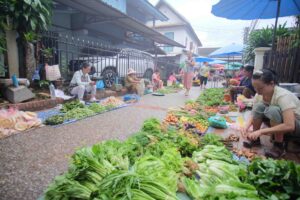
We move from rice-based soups to rice crepes at a street stall across town. A young man sits surrounded by the culinary clutter of his singular dish – bowls of eggs, elephant ear mushrooms, plates, and oil. He ladles rice crepe mixture across a stretched piece of fabric on a hot coal cauldron. He folds in the mushrooms and then cracks an egg on the ready crepe. It’s rolled, placed on a dish, and sprinkled with crispy shallots. This dish, nem khao is “sep lai,” I say, ‘very good’. It’s seriously delicious. If it wasn’t my second or third dish of the day, I’d have ordered one more.
I’d be in good company. The Lao love their food so much that when they meet and greet, they don’t ask each other how they are but if they have eaten breakfast, or lunch yet. I had had more than one of those but was hankering after something sweet.
Khao nom khok (coconut pancakes) are the perfect pick-me-up. Bite-sized, moreishly good, not overly sweet, and very filling. We pedal to the stall of the coconut pancake queen, opposite the town’s police station. Ms. Bee has been making and selling khao nom khok for the last 27 years in the same spot under her umbrella. Locals draw up in cars and on scooters to take away her punnets of coconut snacks. Khao nom khok is made from coconut milk mixed with a little bit of sugar, and sticky rice powder. It’s ladled into half-moon indents in a heavy pan and cooked over coals.
We sit down at Ms. Bee’s stall and are served our sweets on a banana leaf. I’m so eager I can’t wait and manage to burn my tongue on the hot puds. Ms. Bee’s khao nom khok are sweet, but delicately so. Mr. Oun reckons Ms. Bee’s khao nom khok are so popular because she gets the balance of ingredients right. We can’t eat all ten at once so carry the punnet with us to the mulberry paper-making village to cycle off a few calories before heading to the papaya salad stall. When I returned to my hotel, I lay down for a much-needed rest. But I have a sneaky feeling I continued my foodie journey that night at a Lao restaurant recommended by Mr. Oun. Khop Chai Laos!
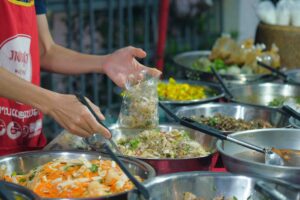
GETTING THERE
Lao Airlines flies regularly to Luang Prabang from Vientiane and other cities in the region.
MORE INFO
Tiger Trail operates this half-day foodie tour. For bookings, visit laos-adventures.com
Text BY Claire Boobbyer
PHOTOGRAPHS BY Anita Preston / Evensong Film



 ລາວ
ລາວ